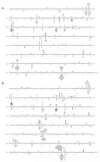Deposition of histone H2A.Z by the SWR-C remodeling enzyme prevents genome instability
- PMID: 25463393
- PMCID: PMC4276476
- DOI: 10.1016/j.dnarep.2014.10.010
Deposition of histone H2A.Z by the SWR-C remodeling enzyme prevents genome instability
Abstract
The yeast SWR-C chromatin remodeling enzyme catalyzes chromatin incorporation of the histone variant H2A.Z which plays roles in transcription, DNA repair, and chromosome segregation. Dynamic incorporation of H2A.Z by SWR-C also enhances the ability of exonuclease I (Exo1) to process DNA ends during repair of double strand breaks. Given that Exo1 also participates in DNA replication and mismatch repair, here we test whether SWR-C influences DNA replication fidelity. We find that inactivation of SWR-C elevates the spontaneous mutation rate of a strain encoding a L612M variant of DNA polymerase (Pol) δ, with a single base mutation signature characteristic of lagging strand replication errors. However, this genomic instability does not solely result from reduced Exo1 function, because single base mutator effects are seen in both Exo1-proficient and Exo1-deficient pol3-L612M swr1Δ strains. The data are consistent with the possibility that incorporation of the H2A.Z variant by SWR-C may stimulate Exo1 activity, as well as enhance the fidelity of replication by Pol δ, the repair of mismatches generated by Pol δ, or both.
Keywords: Chromatin remodeling; Exonuclease 1; Genome instability; H2A.Z; Mismatch repair.
Copyright © 2014 Elsevier B.V. All rights reserved.
Figures



References
-
- Clapier CR, Cairns BR. The biology of chromatin remodeling complexes. Annual review of biochemistry. 2009;78:273–304. - PubMed
-
- Kalocsay M, Hiller NJ, Jentsch S. Chromosome-wide Rad51 spreading and SUMO-H2A.Z-dependent chromosome fixation in response to a persistent DNA double-strand break. Molecular cell. 2009;33:335–343. - PubMed
Publication types
MeSH terms
Substances
Grants and funding
LinkOut - more resources
Full Text Sources
Other Literature Sources
Molecular Biology Databases

